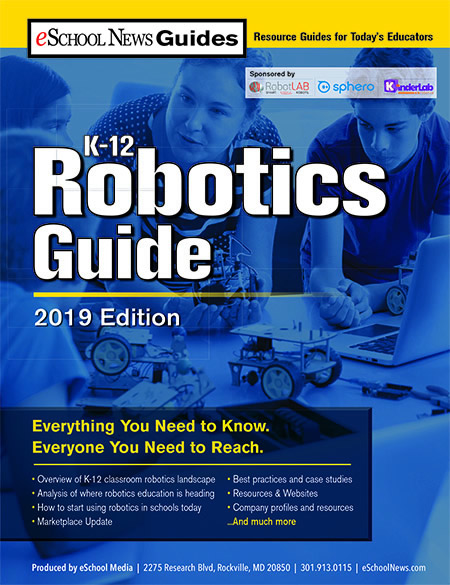Demographics
Hatboro-Horsham School District, located in suburban Philadelphia, has a strong history of academic excellence. Serving approximately 5,000 students, the district provides education from grades K-12.
It has received blue ribbon honors from both the Pennsylvania and United States Departments of Education. Hatboro-Horsham’s schoolboard, parents, teachers, and staff are committed to moving into the future of education.
Related content: Reducing mobility and improving outcomes for at-risk students
Biggest challenge
We wanted to implement new programs for students, including expanded accommodations for ELL and non-English-speaking students in an increasingly diverse district. Our team wanted to find ways to reinvest funds in programs that make our schools a more effective and welcoming learning environment.
Related Content:
eSchool News Robotics Guide
The eSchool News Robotics Guide is here! It features strategies to help you effectively integrate robotics into instruction, along with tips to find the right robotics resources to successfully teach key concepts. A new eSchool News Guide will launch each month–don’t miss a single one!
But like most school districts, Hatboro-Horsham had limited funds. We knew we would need to find the budget by reducing costs elsewhere. At the same time, we didn’t want education or the student experience to suffer due to deep cuts. What we needed were cost-efficient improvements.
Solutions
Over the past 15 years, the district has saved tens of thousands of dollars thanks to improved processes and strategic implementations resulting from our partnership with Ricoh. When we needed to find budget for expanded student programs, we once again turned to a partner who had previously found creative ways to help us unlock major savings.
To accomplish this, the team conducted an in-depth, holistic analysis of the district’s printing fleet and discovered that the heart of the challenge was a lack of centralized monitoring and management. Over the years, printers had been added in a piecemeal fashion, with little oversight or overarching strategy.
It became difficult to tell who was printing what and why, or to conduct day-to-day analysis of device utilization across the fleet. Having this information could empower our IT team to intelligently manage and scale our fleet on an ongoing basis, helping to keep our print operations in an optimized – and ultra-cost-efficient – state long after initial implementation.
Furthermore, the devices in the fleet were aging, resulting in downtime that created problems for students, faculty and IT staff alike. The district needed to eliminate underutilized devices, implement upgraded multifunction printers (MFPs) to serve diverse needs at lower costs, and create transparency throughout the fleet.
With this in mind, the team designed and implemented a bold solution. First, the fleet was reduced by 150 devices, including the elimination of under-utilized single-function desktop printers. Then, the schools’ existing PaperCut™ MF authentication software implementation was expanded, leveraging MFPs’ newly added card readers to collect usage data that could be used to make informed decisions about fleet optimization going forward.
Ricoh took over basic maintenance, which had plagued the IT staff with high volumes of break-fix and routine upkeep for the aging fleet. Now, the Ricoh Managed Services Support Center (RMSSC) would automatically replenish toner as needed, in addition to providing analysis and support. This allowed IT staffers to focus their efforts on core tasks and continual improvements.
At the same time, mobile printing for tablets and laptops was rolled out at the high school, demonstrating the district’s responsiveness to the changing ways students, faculty and staff work.
Lessons learned
• Taking a close look at your budget with some expert assistance can help find savings you might otherwise miss.
• Spending less doesn’t have to mean getting less.
• Sometimes the most effective upgrade a school can make is in its day-to-day processes and device usage. Seemingly small “background” changes can make a big difference, as a dollar here and a dollar there going back into the budget starts to add up.
Next steps
• Invest in expanded student programs, including accommodations for foreign-language students.
• Roll out mobile printing to the middle and elementary schools for continuity and ease of use.
- High school students say AI will change the workforce - April 18, 2024
- Motivating students using the Self-Determination Theory - April 17, 2024
- Michigan Virtual’s statewide workgroup releasing AI guidance for K-12 educators - April 17, 2024


